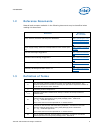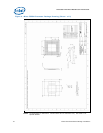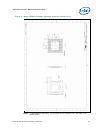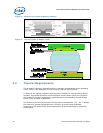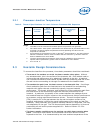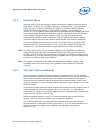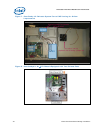
Processor Thermal/Mechanical Information
Thermal and Mechanical Design Guidelines 17
depending on clip stiffness, the initial preload at beginning of life of the product may
be significantly higher than the minimum preload that must be met throughout the life
of the product.
Refer to
Appendix A for clip load metrology guidelines.
2.1.2.3 Heatsink Attach Mechanism Design Considerations
In addition to the general guidelines given above, the heatsink attach mechanism for
the processor should be designed to the following guidelines:
• Solder joint reliability compliant with INTEL quality specification before & after
reliability test such as shock & vibration. The Critical-To-Function (CTF) corner
solder joints of processor package for Intel
®
Desktop Board D201GLY2 experience
high stress concentration during shock and vibration test, therefore the “vertical
lock-down” alignment feature is integrated into z-clip design to prevent solder
joints failures. Please refer to the datasheet for CTF and NCTF locations.
• Vertical Lock-Down Alignment Feature. Generic z-clip solution should include this
feature to improve structural performance during shock and vibration test. The
vertical lock-down feature is basically an additional feature (bends etc.) that is
incorporated into the z-clip to better constraint the heatsink. The reference
thermal solution adds a vertical bend that contacts the heatsink after preload
application. This in turn provides a 4 contact constraint as opposed to the 2
contact constraint as shown in
Figure 4 (thru z-clip center indentation). Note that
the vertical lock feature sizing must be determined thru FOC (First Order
Calculation) or FEA (Finite Element Analysis) to ensure it touches the heatsink
base just enough to provide the required restraint without causing the center
indent feature losing contact. Refer to
Figure 4 for further illustration.
• Figure 5 illustrates solder crack types.
• Heatsink should be held in place under mechanical shock and vibration events and
applies force to the heatsink base to maintain desired pressure on the thermal
interface material. Note that the load applied by the heatsink attach mechanism
must comply with the package specifications described in the processor datasheet.
One of the key design parameters is the height of the top surface of the processor
die above the motherboard, is expected in the range of 2.73 mm ± 0.125 mm.
This data is provided for information only, and should be derived from:
⎯ The height of the package, from the package seating plane to the top of the
die, and accounting for its nominal variation and tolerances that are given in
the corresponding processor datasheet.
• Engages easily, and if possible, without the use of special tools. In general, the
heatsink is assumed to be installed after the motherboard has been installed into
the chassis. Ergo force requirement states that assembly force shall not exceed
15lbf (target is 10lbf).
• Minimizes contact with the motherboard surface during installation and actuation
to avoid scratching/damaging the motherboard.



